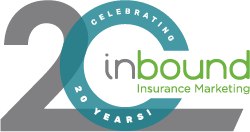Insurance Copywriting: Big Words = Small Response

Have you ever visited an insurance website that’s packed with jargon? It’s burdensome, right? You can’t breeze through and quickly glean information. You have to slow down and read slowly. Who has time for that? Do you believe the myth that affluent people routinely communicate with five-syllable words? Of course not. As a group, the “affluents” usually talk just like regular people. However, if you review financial planning websites, you’ll notice that many companies make the mistake of talking to their affluent audiences in a boring third person voice, using as many big words as possible.
Whatever your audience, we don’t recommend big words in insurance or B2B copywriting. Over the years we’ve noticed that conversion rates are closely tied to comprehension rates. And, when copy is packed with jargon and four-syllable words, comprehension goes down and response rates dive.
Writing with big words is like driving a truck with giant tires. It makes you look like you’re trying to prove something. Leonardo da Vinci once said, “Simplicity is the ultimate sophistication.” We couldn’t agree more. And that is why we love this post from marketing master, Bob Bly.
The Myth of “High-Falutin” Copy by Robert W. Bly
I have dealt with this complaint before, but it comes up every now and then, and recently, I heard it from a new client who wanted to sell Web services to marketing managers at Fortune 500 and middle market corporations.
“This copy is too simple,” the client said. “This sounds as if you are talking to small business owners. Our audience is senior managers at Fortune 500 companies. The tone needs to be much more professional and sophisticated.”
Oh, really? Says who?
One of the biggest misconceptions about writing to CEOs, CFOs, and other senior executives is that they speak some alien language that has only a passing resemblance to the conversational or written English you and I use every day … and that, to sell to this special audience, you have to emulate or copy this special language.
But the reality is: C-level executives put their pants on one leg at a time just like everyone else. They read the same newspapers you do … go to the same movies … listen to the same radio stations … watch the same TV shows.
Yes, it’s smart marketing to understand your audience and then write copy that speaks to their specific needs, fears, concerns, problems, and desires.
And you want to tailor the tone and style of your language to your audience to a reasonable degree. For instance, you wouldn’t use off-color language when writing to ministers. Or use equations in differential calculus when writing to factory workers.
But ministers, chemists, accountants, engineers, computer programmers, while they all may speak the specialized language of their trade, also speak a common language: the English language. And that’s the language you should use when writing your copy.
How do I know I am right? The same way we know anything about direct marketing: through testing.
I have tested “plain English” copy against “high-falutin” copy numerous times over the span of my quarter-century career in direct marketing … and 99 times out of 100, the same language that works for “ordinary folks” sells just as effectively to CEOs, Ph.D.s, and yes, even rocket scientists.
It is easy enough to see this for yourself. Study the controls in any market, for any kind of product. Collect as many DM packages as you can that you know to be strong controls, because they have been mailed repeatedly.
Now divide them into two piles: those written in plain English vs. those written in jargon, big words, or “high falutin” language. If you have collected a dozen samples, I guarantee that the number in the “plain English” pile will be 12 or 11 … no fewer than that … proving my point.
I recently interviewed more than a hundred CEOs, including those at many Fortune 500 companies, to ghostwrite a book Leadership Secrets of the World’s Most Successful CEOs (Dearborn). Without exception, they were all plain-speaking men and women, using direct, straightforward, conversational language in their written and oral communication.
The world’s most respected writing authorities all agree that good writing is clear, simple, and direct.
“Clutter is the disease of American writing,” writes William Zinsser in On Writing Well (HarperCollins, 2001, p. 7). “We are a society strangling in unnecessary words, circular constructions, pompous frills, and meaningless jargon.”
And what about my claim that good writing is “conversational”?
“You can’t actually write the way you talk,” writes Rudolph Flesch in The Art of Readable Writing (Harper & Row, 1949, p. 82). “You can, however, put a reasonable facsimile of your ordinary talking self on paper. You can purposely put into your writing certain things that will make it sound like talk.” (He cites contractions as one example.)
One other point: I have been writing copy aimed at engineers, scientists, mathematicians, systems analysts, and other “techies” for 25 years. And in all that time, I’ve never been told that the simple, plain English copy I wrote was “too easy to read.”
Of course, you can always test my claim that plain English outpulls “high falutin” language for yourself. Here’s how….
The next time a marketing manager says of your conversational copy, “It’s not professional enough,” offer to do a split test: your version against his.
Then you’ll know definitely what works best for your audience … rather than relying on his (or yours, or my) opinion.
Make sense? Of course. Doing an A/B split test always does, right?
This article appears courtesy of Bob Bly's Direct Response Letter. To learn more visit, www.bly.com.
And for the ultimate simple communication tool, consider an insurance infographic.
